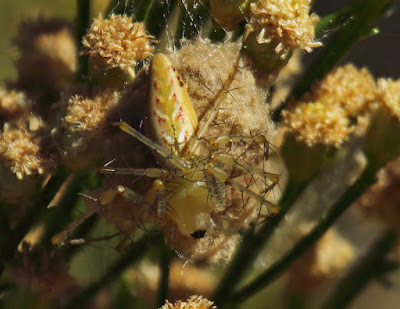I dropped the brownies off at the dessert table --
then ran into a friend who mentioned his wife was volunteering at the Cave Creek Canyon Visitor Information Center that day. So I decided to pay her a visit as it was still before the opening of Oktoberfest. It was the first time I'd been in the visitor center, so Susan gave me a short tour. The former staffer had actually lived there, so there was a small kitchen but not really much more of living quarters than that. In the front public area was a large display of the Chiricahua range, with all the elevation contours marked by lines. But the most interesting part of it was -- it was all carved out of wood. Cave Creek Canyon was there, along with all the other valleys and points of interest. It was quite impressive and unique. (I hope to become a visitor center volunteer myself, so I'll take photos of the inside of the visitor center when I do). The center got even less visitors than usual, so Susan and I went outside to take a tour of the garden area. While keeping watch to see if anyone came by and stopped (there was only one German couple, and as I left an older husband and wife who asked "what's the fastest way to get to Roswell from here?") Susan pointed out bugs on the various flora in the garden. I have a macro system that I was keen to try out on the crawlies -- my 100-400 f/5.6 lens with the 1.4x teleconverter attached and a macro extender added. I wanted the ability to do macro work -- yet at a distance, as I didn't want to disturb my subject -- and not get too close as some of them are poisonous, say a spider. So, with some background info, here are photos of a few of the bugs we saw (most of the IDs came from Facebook pages devoted to spider and insect IDs) --
This is a Crab Spider (of the Misumenoides species). It's a sit-and-wait predator that captures pollinators such as bees that are coming to the flower. And as you can see, it has a pretty good camouflage. It has strong front legs to grab its prey. (After I'd left, Susan took a photo with her iPhone of the crab spider eating a horse fly, with maggots simultaneously exiting the paralyzed fly.)
This one is a Green Lynx spider (Peucetia viridans). It's a female, a little less than a inch long, and it's sitting on an egg sac, which contains 25 to 600 bright orange eggs. The green lynx spider rarely bites humans, but when it does, its bite is venomous and painful , though not deadly. (Nice to know.) They're actually useful in agricultural pest management, for example in cotton fields. (Susan was startled by this one, as its camouflage is quite good.)
Here is another Orbweaver, similar to the one I have in Faranuf's back yard.
Now this is a bug you DEFINITELY want to keep out of your house -- a "kissing bug". They search for blood during the night -- and like to munch on your face, as they're attracted to carbon monoxide coming from your breath. It transmits a deadly disease called Chagas, which has affected 300,000 Americans. The second phase of Chagas can be deadly. The existence of this bug is one of the reasons why I try to keep the inside of Faranuf scrupulously clean. I don't want my face eaten away at night...
This beauty is commonly known as a katydid, or bush cricket. There are more than 6400 species of katydids -- so don't ask me which species this is..They're also known as long-horned grasshoppers, to distinguish them from the true, short-horned grasshoppers.
Closeup of a Clark's Spiny Lizard; I had one of these in my well house (and scared the heck out of me when it dropped onto the ground from a ceiling corner).
And finally -- a tarantula, of course. It's a male; it's much smaller than a female. I check online tarantula sites (yes, they have those) and I'm pretty positive it's a Porch Grey, also known as a "Cochise" tarantula. Of course, Cochise is the name of our county, too...Once again, tarantulas make good pets, and are docile in captivity. So, if you want to scare your friends...
The Chiricahuas have a wealth of insects, bugs and arachnids (joint-legged invertebrates with 8 legs) -- centipedes, millipedes, scorpions, spiders, lizards, snakes, etc. It's one of the things that makes this area so special -- and also gives some the heebie-jeebies.










We had a red-leg tarantula given to us as a wedding present and it lived for 18 years. Wasn't much for cuddling but it made for an interesting topic of discussion.
ReplyDelete